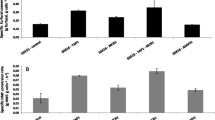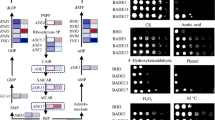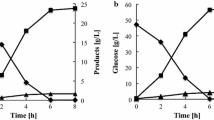Abstract
Acetic acid tolerance and xylose consumption are desirable traits for yeast strains used in industrial biotechnological processes. In this work, overexpression of a weak acid stress transcriptional activator encoded by the gene HAA1 and a phosphoribosyl pyrophosphate synthetase encoded by PRS3 in a recombinant industrial Saccharomyces cerevisiae strain containing a xylose metabolic pathway was evaluated in the presence of acetic acid in xylose- or glucose-containing media. HAA1 or PRS3 overexpression resulted in superior yeast growth and higher sugar consumption capacities in the presence of 4 g/L acetic acid, and a positive synergistic effect resulted from the simultaneous overexpression of both genes. Overexpressing these genes also improved yeast adaptation to a non-detoxified hardwood hydrolysate with a high acetic acid content. Furthermore, the overexpression of HAA1 and/or PRS3 was found to increase the robustness of yeast cell wall when challenged with acetic acid stress, suggesting the involvement of the modulation of the cell wall integrity pathway. This study clearly shows HAA1 and/or, for the first time, PRS3 overexpression to play an important role in the improvement of industrial yeast tolerance towards acetic acid. The results expand the molecular toolbox and add to the current understanding of the mechanisms involved in higher acetic acid tolerance, paving the way for the further development of more efficient industrial processes.





Similar content being viewed by others
References
Almeida JRM, Runquist D, Sànchez Nogué V, Lidén G, Gorwa-Grauslund MF (2011) Stress-related challenges in pentose fermentation to ethanol by the yeast Saccharomyces cerevisiae. Biotechnol J 6:286–299. https://doi.org/10.1002/biot.201000301
Amorim HV, Lopes ML, de Castro Oliveira JV, Buckeridge MS, Goldman GH (2011) Scientific challenges of bioethanol production in Brazil. Appl Microbiol Biotechnol 91:1267–1275. https://doi.org/10.1007/s00253-011-3437-6
Belén Sanz A, García R, Rodríguez-Peña JM, Díez-Muñiz S, Nombela C, Peterson CL, Arroyo J (2012) Chromatin remodeling by the SWI/SNF complex is essential for transcription mediated by the yeast cell wall integrity MAPK pathway. Mol Biol Cell 23:2805–2817. https://doi.org/10.1091/mbc.E12-04-0278
Binley KM, Radcliffe PA, Trevethick J, Duffy KA, Sudbery PE (1999) The yeast PRS3 gene is required for cell integrity, cell cycle arrest upon nutrient deprivation, ion homeostasis and the proper organization of the actin cytoskeleton. Yeast 15:1459–1469. https://doi.org/10.1002/(SICI)1097-0061(199910)15:14<1459::AID-YEA472>3.0.CO;2-A
Bischoff KM, Liu S, Leathers TD, Worthington RE, Rich JO (2009) Modeling bacterial contamination of fuel ethanol fermentation. Biotechnol Bioeng 103:117–122. https://doi.org/10.1002/bit.22244
Chen Y, Stabryla L, Wei N (2016) Improved acetic acid resistance in Saccharomyces cerevisiae by overexpression of the WHI2 gene identified through inverse metabolic engineering. Appl Environ Microbiol 82:2156–2166. https://doi.org/10.1128/AEM.03718-15
Costa CE, Romani A, Cunha JT, Johansson B, Domingues L (2017) Integrated approach for selecting efficient Saccharomyces cerevisiae for industrial lignocellulosic fermentations: importance of yeast chassis linked to process conditions. Bioresour Technol 227:24–34. https://doi.org/10.1016/j.biortech.2016.12.016
Cunha JT, Aguiar TQ, Romaní A, Oliveira C, Domingues L (2015) Contribution of PRS3, RPB4 and ZWF1 to the resistance of industrial Saccharomyces cerevisiae CCUG53310 and PE-2 strains to lignocellulosic hydrolysate-derived inhibitors. Bioresour Technol 191:7–16. https://doi.org/10.1016/j.biortech.2015.05.006
Dominguez E, Romaní A, Domingues L, Garrote G (2017) Evaluation of strategies for second generation bioethanol production from fast growing biomass Paulownia within a biorefinery scheme. Appl Energy 187:777–789. https://doi.org/10.1016/j.apenergy.2016.11.114
Dong Y, Hu J, Fan L, Chen Q (2017) RNA-Seq-based transcriptomic and metabolomic analysis reveal stress responses and programmed cell death induced by acetic acid in Saccharomyces cerevisiae. Sci Rep 7:42659. https://doi.org/10.1038/srep42659
Fernandes AR, Mira NP, Vargas RC, Canelhas I, Sá-Correia I (2005) Saccharomyces cerevisiae adaptation to weak acids involves the transcription factor Haa1p and Haa1p-regulated genes. Biochem Biophys Res Commun 337:95–103. https://doi.org/10.1016/j.bbrc.2005.09.010
Gancedo JM, Gancedo C (1986) Catabolite repression mutants of yeast. FEMS Microbiol Lett 32:179–187. https://doi.org/10.1016/0378-1097(86)90289-2
Garcia R, Bermejo C, Grau C, Perez R, Rodriguez-Pena JM, Francois J, Nombela C, Arroyo J (2004) The global transcriptional response to transient cell wall damage in Saccharomyces cerevisiae and its regulation by the cell integrity signaling pathway. J Biol Chem 279:15183–15195. https://doi.org/10.1074/jbc.M312954200
Geng P, Zhang L, Shi GY (2017) Omics analysis of acetic acid tolerance in Saccharomyces cerevisiae. World J Microbiol Biotechnol 33:94. https://doi.org/10.1007/s11274-017-2259-9
Giannattasio S, Guaragnella N, Ždralević M, Marra E (2013) Molecular mechanisms of Saccharomyces cerevisiae stress adaptation and programmed cell death in response to acetic acid. Front Microbiol 4:33. https://doi.org/10.3389/fmicb.2013.00033
Gietz A, Jean AS, Woods RA, Schiestl RH (1992) Improved method for high efficiency transformation of intact yeast cells. Nucleic Acids Res 20:1425. https://doi.org/10.1093/nar/20.6.1425
Hasunuma T, Sakamoto T, Kondo A (2016) Inverse metabolic engineering based on transient acclimation of yeast improves acid-containing xylose fermentation and tolerance to formic and acetic acids. Appl Microbiol Biotechnol 100:1027–1038. https://doi.org/10.1007/s00253-015-7094-z
Inaba T, Watanabe D, Yoshiyama Y, Tanaka K, Ogawa J, Takagi H, Shimoi H, Shima J (2013) An organic acid-tolerant HAA1-overexpression mutant of an industrial bioethanol strain of Saccharomyces cerevisiae and its application to the production of bioethanol from sugarcane molasses. AMB Express 3:74. https://doi.org/10.1186/2191-0855-3-74
Jönsson LJ, Martín C (2016) Pretreatment of lignocellulose: formation of inhibitory by-products and strategies for minimizing their effects. Bioresour Technol 199:103–112. https://doi.org/10.1016/j.biortech.2015.10.009
Jung US, Levin DE (1999) Genome-wide analysis of gene expression regulated by the yeast cell wall integrity signalling pathway. Mol Microbiol 34:1049–1057. https://doi.org/10.1046/j.1365-2958.1999.01667.x
Keller G, Ray E, Brown PO, Winge DR (2001) Haa1, a protein homologous to the copper-regulated transcription factor Ace1, is a novel transcriptional activator. J Biol Chem 276:38697–38702. https://doi.org/10.1074/jbc.M107131200
Kim SR, Ha SJ, Wei N, Oh EJ, Jin Y-S (2012) Simultaneous co-fermentation of mixed sugars: a promising strategy for producing cellulosic ethanol. Trends Biotechnol 30:274–282. https://doi.org/10.1016/j.tibtech.2012.01.005
Kim SR, Park Y-C, Jin Y-S, Seo J-H (2013) Strain engineering of Saccharomyces cerevisiae for enhanced xylose metabolism. Biotechnol Adv 31:851–861. https://doi.org/10.1016/j.biotechadv.2013.03.004
Lavoie JM, Capek-Menard E, Gauvin H, Chornet E (2010) Production of pulp from Salix viminalis energy crops using the FIRSST process. Bioresour Technol 101:4940–4946. https://doi.org/10.1016/j.biortech.2009.09.021
Lee Y, Nasution O, Choi E, Choi I-G, Kim W, Choi W (2015) Transcriptome analysis of acetic-acid-treated yeast cells identifies a large set of genes whose overexpression or deletion enhances acetic acid tolerance. Appl Microbiol Biotechnol 99:6391–6403. https://doi.org/10.1007/s00253-015-6706-y
Malcher M, Schladebeck S, Mösch HU (2011) The Yak1 protein kinase lies at the center of a regulatory cascade affecting adhesive growth and stress resistance in Saccharomyces cerevisiae. Genetics 187:717–730. https://doi.org/10.1534/genetics.110.125708
Matsushika A, Nagashima A, Goshima T, Hoshino T (2013) Fermentation of xylose causes inefficient metabolic state due to carbon/energy starvation and reduced glycolytic flux in recombinant industrial Saccharomyces cerevisiae. PLoS One 8:e69005. https://doi.org/10.1371/journal.pone.0069005
Mira N, Palma M, Guerreiro J, Sá-Correia I (2010a) Genome-wide identification of Saccharomyces cerevisiae genes required for tolerance to acetic acid. Microb Cell Factories 9:79. https://doi.org/10.1186/1475-2859-9-79
Mira NP, Becker JD, Sá-Correia I (2010b) Genomic expression program involving the Haa1p-regulon in Saccharomyces cerevisiae response to acetic acid. OMICS 14:587–601. https://doi.org/10.1089/omi.2010.0048
Mollapour M, Shepherd A, Piper PW (2009) Presence of the Fps1p aquaglyceroporin channel is essential for Hog1p activation, but suppresses Slt2(Mpk1)p activation, with acetic acid stress of yeast. Microbiology 155:3304–3311. https://doi.org/10.1099/mic.0.030502-0
Moyses DN, Reis VC, de Almeida JR, de Moraes LM, Torres FA (2016) Xylose fermentation by Saccharomyces cerevisiae: challenges and prospects. Int J Mol Sci 17:207. https://doi.org/10.3390/ijms17030207
Muthaiyan A, Limayem A, Ricke SC (2011) Antimicrobial strategies for limiting bacterial contaminants in fuel bioethanol fermentations. PECS 37:351–370. https://doi.org/10.1016/j.pecs.2010.06.005
Parawira W, Tekere M (2011) Biotechnological strategies to overcome inhibitors in lignocellulose hydrolysates for ethanol production: review. Crit Rev Biotechnol 31:20–31. https://doi.org/10.3109/07388551003757816
Pereira FB, Guimarães PM, Gomes DG, Mira NP, Teixeira MC, Sá-Correia I, Domingues L (2011a) Identification of candidate genes for yeast engineering to improve bioethanol production in very high gravity and lignocellulosic biomass industrial fermentations. Biotechnol Biofuels 4:57. https://doi.org/10.1186/1754-6834-4-57
Pereira FB, Guimarães PMR, Teixeira JA, Domingues L (2011b) Robust industrial Saccharomyces cerevisiae strains for very high gravity bio-ethanol fermentations. J Biosci Bioeng 112:130–136. https://doi.org/10.1016/j.jbiosc.2011.03.022
Pereira FB, Romaní A, Ruiz HA, Teixeira JA, Domingues L (2014a) Industrial robust yeast isolates with great potential for fermentation of lignocellulosic biomass. Bioresour Technol 161:192–199. https://doi.org/10.1016/j.biortech.2014.03.043
Pereira FB, Teixeira MC, Mira NP, Sá-Correia I, Domingues (2014b) Genome-wide screening of Saccharomyces cerevisiae genes required to foster tolerance towards industrial wheat straw hydrolysates. J Ind Microbiol Biotechnol 41:1753–1761. https://doi.org/10.1007/s10295-014-1519-z
Pereira F, Azevedo F, Carvalho A, Ribeiro GF, Budde MW, Johansson B (2015) Pydna: a simulation and documentation tool for DNA assembly strategies using python. BMC Bioinformatics 16:142. https://doi.org/10.1186/s12859-015-0544-x
Rego A, Duarte AM, Azevedo F, Sousa MJ, Corte-Real M, Chaves SR (2014) Cell wall dynamics modulate acetic acid-induced apoptotic cell death of Saccharomyces cerevisiae. Microb Cell 1:303–314. https://doi.org/10.15698/mic2014.09.164
Romaní A, Pereira F, Johansson B, Domingues L (2015) Metabolic engineering of Saccharomyces cerevisiae ethanol strains PE-2 and CAT-1 for efficient lignocellulosic fermentation. Bioresour Technol 179:150–158. https://doi.org/10.1016/j.biortech.2014.12.020
Runquist D, Hahn-Hägerdal B, Bettiga M (2010) Increased ethanol productivity in xylose-utilizing Saccharomyces cerevisiae via a randomly mutagenized xylose reductase. Appl Environ Microbiol 76:7796–7802. https://doi.org/10.1128/AEM.01505-10
Saithong P, Nakamura T, Shima J (2009) Prevention of bacterial contamination using acetate-tolerant Schizosaccharomyces pombe during bioethanol production from molasses. J Biosci Bioeng 108:216–219. https://doi.org/10.1016/j.jbiosc.2009.03.022
Sakihama Y, Hasunuma T, Kondo A (2015) Improved ethanol production from xylose in the presence of acetic acid by the overexpression of the HAA1 gene in Saccharomyces cerevisiae. J Biosci Bioeng 119:297–302. https://doi.org/10.1016/j.jbiosc.2014.09.004
Sànchez i, Nogué V, Narayanan V, Gorwa-Grauslund MF (2013) Short-term adaptation improves the fermentation performance of Saccharomyces cerevisiae in the presence of acetic acid at low pH. Appl Microbiol Biotechnol 97:7517–7525. https://doi.org/10.1007/s00253-013-5093-5
Simões T, Mira NP, Fernandes AR, Sá-Correia I (2006) The SPI1 gene, encoding a glycosylphosphatidylinositol-anchored cell wall protein, plays a prominent role in the development of yeast resistance to lipophilic weak-acid food preservatives. Appl Environ Microbiol 72:7168–7175. https://doi.org/10.1128/AEM.01476-06
Skinner KA, Leathers TD (2004) Bacterial contaminants of fuel ethanol production. J Ind Microbiol Biotechnol 31:401–408. https://doi.org/10.1007/s10295-004-0159-0
Sugiyama M, Akase SP, Nakanishi R, Horie H, Kaneko Y, Harashima S (2014) Nuclear localization of HAA1, which is linked to its phosphorylation status, mediates lactic acid tolerance in Saccharomyces cerevisiae. Appl Environ Microbiol 80:3488–3495. https://doi.org/10.1128/AEM.04241-13
Swinnen S, Henriques SF, Shrestha R, Ho PW, Sá-Correia I, Nevoigt E (2017) Improvement of yeast tolerance to acetic acid through Haa1 transcription factor engineering: towards the underlying mechanisms. Microb Cell Factories 16:7. https://doi.org/10.1186/s12934-016-0621-5
Tanaka K, Ishii Y, Ogawa J, Shima J (2012) Enhancement of acetic acid tolerance in Saccharomyces cerevisiae by overexpression of the HAA1 gene, encoding a transcriptional activator. Appl Environ Microbiol 78:8161–8163. https://doi.org/10.1128/AEM.02356-12
Teixeira MC, Monteiro PT, Palma M, Costa C, Godinho CP, Pais P, Cavalheiro M, Antunes M, Lemos A, Pedreira T, Sá-Correia I (2017) YEASTRACT: an upgraded database for the analysis of transcription regulatory networks in Saccharomyces cerevisiae. Nucleic Acids Res gkx842. https://doi.org/10.1093/nar/gkx842
Terashima H, Yabuki N, Arisawa M, Hamada K, Kitada K (2000) Up-regulation of genes encoding glycosylphosphatidylinositol (GPI)-attached proteins in response to cell wall damage caused by disruption of FKS1 in Saccharomyces cerevisiae. Mol Gen Genet 264:64–74. https://doi.org/10.1007/s004380000285
Thomas KC, Hynes SH, Ingledew WM (2001) Effect of lactobacilli on yeast growth, viability and batch and semi-continuous alcoholic fermentation of corn mash. J Appl Microbiol 90:819–828. https://doi.org/10.1046/j.1365-2672.2001.01311.x
Träff KL, Otero Cordero RR, van Zyl WH, Hahn-Hägerdal B (2001) Deletion of the GRE3 aldose reductase gene and its influence on xylose metabolism in recombinant strains of Saccharomyces cerevisiae expressing the xylA and XKS1 genes. Appl Environ Microbiol 67:5668–5674. https://doi.org/10.1128/AEM.67.12.5668-5674.2001
Wang K, Vavassori S, Schweizer LM, Schweizer M (2004) Impaired PRPP-synthesizing capacity compromises cell integrity signalling in Saccharomyces cerevisiae. Microbiology 150:3327–3339. https://doi.org/10.1099/mic.0.27373-0
Zabed H, Sahu JN, Boyce AN, Faruq G (2016) Fuel ethanol production from lignocellulosic biomass: an overview on feedstocks and technological approaches. Renew Sust Energ Rev 66:751–774. https://doi.org/10.1016/j.rser.2016.08.038
Zhang MM, Zhao XQ, Cheng C, Bai FW (2015) Improved growth and ethanol fermentation of Saccharomyces cerevisiae in the presence of acetic acid by overexpression of SET5 and PPR1. Biotechnol J 10:1903–1911. https://doi.org/10.1002/biot.201500508
Funding
This study was supported by the Portuguese Foundation for Science and Technology (FCT) by the strategic funding of UID/BIO/04469/2013 unit, MIT-Portugal Program (PhD grant PD/BD/128247/2016 to Joana T. Cunha), COMPETE 2020 (POCI-01-0145-FEDER-006684), BioTecNorte operation (NORTE-01-0145-FEDER-000004) and MultiBiorefinery project (POCI-01-0145-FEDER-016403). Funding received by Institute for Bioengineering and Biosciences (IBB) from FCT (UID/BIO/04565/2013) and from Programa Operacional Regional de Lisboa 2020 (Project No. 007317) is acknowledged. BJ was supported through the strategic program UID/BIA/04050/2013 (POCI-01-0145-FEDER-007569) funded by national funds through the FCT I.P. and by the ERDF through the COMPETE2020—Programa Operacional Competitividade e Internacionalização (POCI).
Author information
Authors and Affiliations
Corresponding author
Ethics declarations
Conflict of interest
The authors declare that they have no conflict of interest.
Ethical approval
This article does not contain any studies with human participants or animals performed by any of the authors.
Electronic supplementary material
ESM 1
(PDF 324 kb)
Rights and permissions
About this article
Cite this article
Cunha, J.T., Costa, C.E., Ferraz, L. et al. HAA1 and PRS3 overexpression boosts yeast tolerance towards acetic acid improving xylose or glucose consumption: unravelling the underlying mechanisms. Appl Microbiol Biotechnol 102, 4589–4600 (2018). https://doi.org/10.1007/s00253-018-8955-z
Received:
Revised:
Accepted:
Published:
Issue Date:
DOI: https://doi.org/10.1007/s00253-018-8955-z




